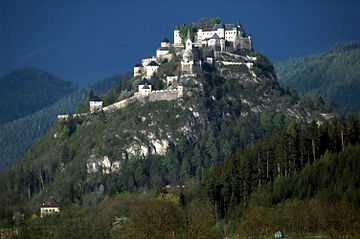Khevenhüller
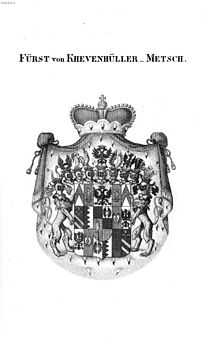
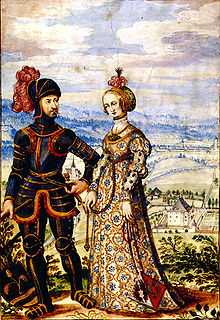
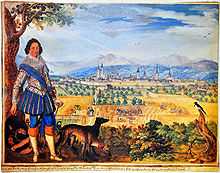
Khevenhüller is the name of a Carinthian noble family, documented there since 1356, which originally came from the Upper Palatinate in Franconia, and which later had their principal seat in Landskron Castle. In the 16th century, the family split into the two branches of Khevenhüller-Frankenburg, Reichsgrafen (i.e. counts of the realm) since 1593, and Khevenhüller-Hochosterwitz, Reichsgrafen since 1725 and, as Khevenhüller-Metsch, Fürsten (i.e. princes) since 1763.
In present-day Carinthia, the princely family of Khevenhüller-Metsch operates the tourist attraction of Hochosterwitz Castle, one of their Renaissance homes.
History
The earliest mention of a Khevenhüller is of one Ulreich "dem Chevenhuelaer" 1330,[1] and in Carinthia of one Johann I Khevenhüller, who died in 1356 and was the son-in-law of Richard I von Khünburg and Elisabeth von Himmelberg,[2] both from Carinthia. Johann IV von Khevenhüller zu Aichelberg (b. ca 1420-1462) was the first to hold the family title "of Aichelberg",[3] yet Johann V Khevenhüller (d. 1462), son of Wilhelm II Khevenhüller and Margareta von Auersperg, was Burgrave of Federaun, whereas his son, Augustin Khevenhüller, who died 1516, is referred to as Herr (i.e. Lord) of Hardegg.[4] His mother was one "Miss" von Lindegg,[5] who together with her grandson Sigismund III, Herr Khevenhüller in Hohen-Osterwitz (1507–1558) appears among the ancestors of Prince Charles.[6] Her youngest grandson, Bernard von Khevenhüller (1511–1548) was "Herr auf Sternberg and Hohenwart"; her eldest grandson, Christoph Khevenhüller (1503–1557) was Lord of Aichelberg.
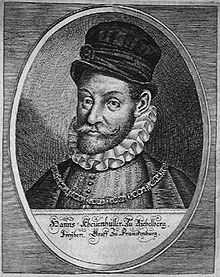
Christoph Khevenhüller
The steep rise of the House of Khevenhüller in Carinthia began when in 1525 Christoph Khevenhüller (1503 -1557) was appointed castellan of Ortenburg Castle near Spittal an der Drau and married a wealthy burgher's daughter, Elizabeth Mansdorfer. Her wealth enabled him to acquire a number of properties in Carinthia such as the castles of Aichelberg, Ortenburg, Sommeregg, Hochosterwitz and Landskron as well as the iron mine of Eisentratten near Gmünd. Like the majority of the Carinthian Estates Christoph Khevenhüller became a Lutheran Protestant. Of Christoph Khevenhüller's s three sons, Hans, Moritz and Bartlmä, two were politically and economically most successful, thus furthering the rise of the family:
Hans Khevenhüller
Hans Khevenhüller (1538–1606) became the Legate of the Holy Roman Emperor at the Spanish court, an office that he held for 26 years. He was appointed Imperial Chamberlain, was made a Knight of the Order of the Golden Fleece in 1587 and a count in 1593, a rank that upon his death passed on to his brother Bartlmä.
Bartlmä Khevenhüller
The activities of Bartlmä Khevenhüller (1539–1613) centred on Carinthia. Styling himself "Freiherr auf Landskron and Wernberg" he made it to Burggrave und Speaker of the Estates, and managed to make the Khevenhüller family one of the wealthiest in the German Reich. He also figured as the head of the Protestants in Carinthia.
When in the course of the counter-reformation Emperor Ferdinand II abolished the nobility's religious freedom in the Habsburg lands, the Protestant members of the Khevenhüller family were forced to abandon their possessions in Carinthia and emigrated to Germany in 1628. Among these was also the great-grandmother of Nicolaus Ludwig Reichsgraf von Zinzendorf und Pottendorf of the Moravian Church or Herrnhuter Brüdergemeine. Interrelation with the noble Saxonian Metzsch family began that led to the Khevenhüller-Metsch branch, which later also spread to Spain where as marquesses and dukes they became Grandees of Spain.
Paul Khevenhüller
Being a Protestant Paul Khevenhüller (1593–1655) sided with the Swedish king during the Thirty Years' War lending Gustav Adolf 70 000 Swedish riksdalers to finance the war. After the king's death the Swedish state was incapable of repaying the loan and compensated the lender with the property of Julita Gård in Södermanland, which remained the residence of his descendants late into the 19th century.
Notable members of the House of Khevenhüller
- Ulrich Khevenhüller (b. ca. 1430–1492), youngest son of Hans II Khevenhüller, knight
- George Khevenhüller (1533–1587), "State Captain", i.e. governor of the Duchy of Carinthia.
- Hans Graf Khevenhüller-Frankenburg (1538–1606), Imperial ambassador to the Spanish Court.
- Franz Christoph Graf von Khevenhüller-Frankenburg (1588–1650), Imperial ambassador to the Spanish Court
- Paul Khevenhüller (1593–1655), financier of the Swedish king in the Thirty Years' War
- Sigmund Friedrich von Khevenhüller (1666–1742), governor of the Duchy of Carinthia, vicegerent[7] of the Duchy of Lower Austria.
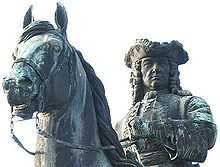
field marshal. (Part of the Maria-Theresa monument in Vienna)
- Ludwig Andreas Khevenhüller Graf von Aichelberg-Frankenburg (1683–1744), Austrian field marshal
- Johann Joseph Fürst Khevenhüller-Metsch (1706–1776), Lord Great Chamberlain ("Oberstkämmerer") of Maria Theresa
- Johann Carl Khevenhüller (1839–1905), member of Maximilian I of Mexico's corps of volunteers
Princes of Khevenhüller-Metsch
- Johann Joseph Khevenhüller-Metsch(1706–1776), son of the former, 1763 Prince von Khevenhüller-Metsch; married to Karolina Maria Augustina Countess von Metsch, daughter of Count Johann Adolf
- Johann Sigismund Friedrich (1732–1801), son of the former, 2nd Prince von Khevenhüller-Metsch; ∞ I Maria Amalia Susanna, Princess of Liechtenstein, daughter of Prince Emanuel; married to II Marie Josephine Henriette Barbara Countess of Strassoldo, daughter of Vinzenz
- Karl Maria Joseph Johann Baptist Clemens (1756–1823), son of the former, 3rd Prince von Khevenhüller-Metsch; married to Therese Countess Morzin, daughter of Karl Joseph
- Franz Maria Johann Joseph Hermann (1762–1837), brother of the former, 4th Prince von Khevenhüller-Metsch; married to I Maria Elisabeth Countess of Kuefstein, daughter of Johann Adam; married to II Maria Josepha Countess of Abensberg and Traun, daughter of Otto; married to III Christina Countess Zichy of Zich and Vasonykeö, daughter of Karl
- Richard Maria Johann Basil (1813–1877), son of the former, 5th Prince zu Khevenhüller-Metsch; married to Antonia Maria Countess Lichnowsky, daughter of Prince Eduard
- Johannes Franz Karl Eduard Joseph Nemesius (1839–1905), son of the former, 6th Prince zu Khevenhüller-Metsch; married to Eduardine Countess von Clam-Gallas, daughter of Eduard
- Anton Sigismund Joseph Maria (1873–1945), nephew of the former, until 1918 (abolishment of aristocracy) the 7th Prince zu Khevenhüller-Metsch; married to Gabriele Countess von Mensdorff-Pouilly
- Franz Khevenhüller-Metsch (1889–1977); married to Anna Princess zu Fürstenberg (1894–1928), daughter of Maximilian Egon Prince zu Fürstenberg
- Maximilian Khevenhüller-Metsch (1919–2010) married to Wilhelmine Gräfin Henckel von Donnersmarck (b. 1932), daughter of Lazarus Graf Henckel von Donnersmarck (1902–1991) and Franziska Gräfin von und zu Eltz (1905–1997)
- Johannes Khevenhüller-Metsch (b. 1956); married to Donna Camilla Borghese dei Principi di Nettuno (* 1962)
Actual Head of the Khevenhüller-Metsch Family
- Johannes Khevenhüller-Metsch (b. 1956); married to Donna Camilla Borghese dei Principi di Nettuno (* 1962)
Spanish branch
- Don Camilo Ruspoli y Khevenhüller-Metsch, Marescotti-Capizucchi y Liechtenstein, dei Principi Ruspoli (1788–1864), married to Carlota de Godoy, 2nd Duchess of Sueca
- Don Luigi Ruspoli y Godoy, de Khevenhüller-Metsch y Borbón, dei Principi Ruspoli, 3rd Marquis of Boadilla del Monte (1828–1893),
- Don Adolfo Ruspoli y Godoy di Bassano, de Khevenhüller-Metsch y Borbón, dei Principi Ruspoli, 2nd Duke of Alcudia (1822–1914), Grandee of Spain First Class
See also: Line of succession to the British throne
- Countess Hemma von Khevenhüller-Metsch (b. 1994)
- Countess Teresa von Khevenhüller-Metsch (b. 1996)
Notes
- ↑ Collegium es nobilis Austriae: Khevenhüller-Metsch
- ↑ Our... Ancestors - Person Page 3739
- ↑ Marek, Miroslav. "Euweb: Khevenhüller family". Genealogy.EU.
- ↑ Our...ancestors.com
- ↑ Our ...Ancestors Person Page 3734
- ↑ Gerald Paget, The Lineage and Ancestry of H.R.H. Prince Charles, Prince of Wales, S1157, S11572, vol. II, pp. 239 and 378
- ↑ often incorr. called ″vice-regent". The Cassell English Dictionary, London 1990, p. 1469
References
- Bernhard Czerwenka, Die Khevenhüller, Vienna: Braumüller, 1867.
- Karl Dinklage, Kärnten um 1620. Die Bilder der Khevenhüllerchronik, Vienna: Edition Tusch, 1980.
- Franz Müllner,Johann Carl Fürst Khevenhüller-Metsch, ein Kampfgefährte Kaiser Maximilians von Mexiko. In Maximilian von Mexiko 1832-1867, Vienna: Enzenhofer, 1974.
External links
- Burg Hochosterwitz
- Website of Hochosterwitz Castle (owned by the princely family of Khevenhüller-Metsch)
- Collegium es nobilis Austriae: Khevenhüller-Metsch
- Marek, Miroslav. "Euweb: Khevenhüller genealogy". Genealogy.EU.
- Early Khevenhüllers
- Marek, Miroslav. "Genealogy Ruspoli y Khevenhüller-Metsch". Genealogy.EU.
